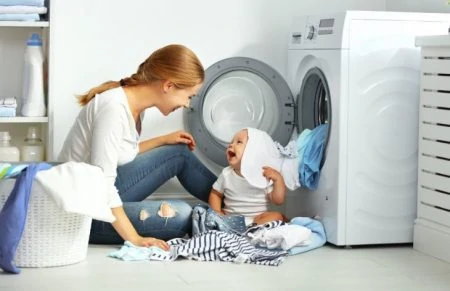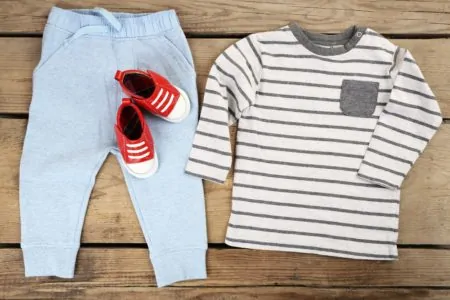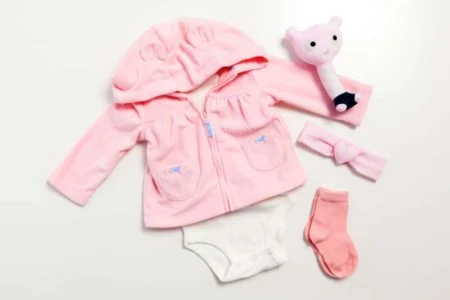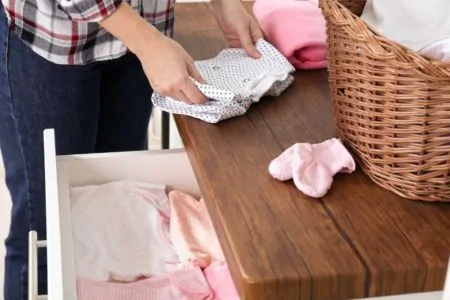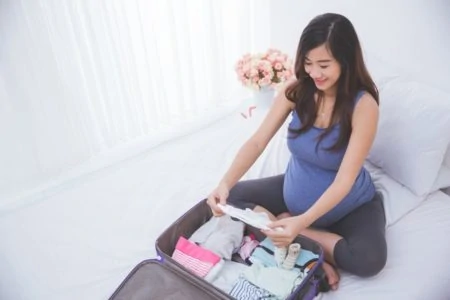Did you know that you probably have a pile of cash lying in your baby’s closet? Don’t run off and check just yet, but hear me out.
Many people think about selling their baby clothes but quickly get discouraged, thinking it’ll be too much work, especially with a little one underfoot. It does take a little work, but we’ve found the effort is minimal — and so worth it! We’ve been doing this for years and have been pleasantly surprised by the money we’ve made selling our little ones’ outgrown clothes.
We’ll help you avoid the mistakes we made when we started and give you step-by-step instructions for using a variety of online and offline platforms.
Read on to learn all you need to know to sell your baby clothes and turn those tiny threads into big dollars.
Key Takeaways
- Sort baby clothes into sell, donate, or repurpose categories based on their condition.
- Clean and organize sellable items by size and season for easier selling.
- Choose a platform for selling, such as online consignment, local consignment shops, yard sales, or social media.
- Balance the potential earnings from selling baby clothes with the time and effort involved.
Getting Ready to Sell Baby Clothes
First, you’ll have to clean out that baby closet and gather all the items that no longer fit. Depending on the size of your child’s clothing stash, it could take a few minutes or many hours. It’s probably a good idea to wait until naptime or when someone else can keep an eye on your baby.
Once you’ve gathered all the items you no longer need, you’re ready for the sorting!
1. Sell vs. Donate
By now, you probably have a bunch of tiny clothing items strewn about your living room. It’s time to grab your bins — you’ll probably need several, especially if you have a lot of clothing. (If you don’t have empty containers, you can find plenty of options on Amazon!)
The first round of sorting will be a little time-consuming because you will have to inspect the items for stains, holes, and style. Not every piece of clothing will be fit for sale. Take a careful look at each piece, using a critical eye.
Excellent Condition
Yay! These are the clothes that are fit for sale. Each piece should be completely free of stains, holes, or tears.
They must also be relatively current, purchased in the last 3–5 years. Well-known, quality brands like Gymboree, BabyGap, and Oshkosh usually sell really well.
Any piece that fits into this category should be set aside for further sorting.
Decent Condition
These are the items that look pretty good, but they aren’t perfect. They might have a few minor stains or tiny tears around snaps or buttons. All in all, they look good, but they don’t hold up to tough scrutiny.
These clothing items make good hand-me-downs. Do you know someone who recently had a baby? Perhaps they could use some free, good-quality baby attire.
Another option is to donate these items to a local thrift shop or shelter, which is tax-deductible!
Poor Condition
Not every clothing item is going to escape babyhood in pristine condition. Diaper blowouts and spit-ups happen, and they can leave some pretty tough stains. White onesies are often the hardest hit.
You won’t be able to sell these items, and they probably aren’t in good enough condition to give to your friends or family either. Plus, you don’t want to drop off a bunch of stained clothes at the thrift store.
So, what do you do with them? One option is to turn them into cleaning rags or recycle them for craft projects. You could also check with a local day care or church nursery. They may have a stack of clothes to use in case of an emergency.
You can also look for a Planet Aid bin for donating textiles. They’ll find ways to reuse or repurpose the clothing, improving the environment by reducing greenhouse gases.
Editor's Note:
Katelyn Holt RN, BSN, BC2. Further Sorting
Now, it’s time to move on to the sellable items.
You’ll need to sort the clothes from the excellent pile further before you’re ready to start making some cash. The large stack will need to be broken down by size and season.
- Size: All items need to be sorted into groups by their tag size. It can be easier to sell your items in sized lots, especially if you’re selling them at yard sales.
- Season: Once you have the clothes separated by size, break the sizes down by season. Sorting by season will be especially important if you sell at consignment stores.
Now you see the need for all the bins.
3. Clean and Wrinkle-Free
The most important thing you’ll need to do if you want a consignment shop to purchase your clothes is to ensure they’re clean and wrinkle-free. Since you gathered them from the closet, they’re probably already clean. However, they may not be clean enough.
A consignment shop may turn down items if they smell musty — like they’ve been shoved in the back of a closet for six months (which they probably have).
They might also turn down clothes that smell too heavily perfumed or fragranced. Very wrinkled clothes can be turned down, too.
To improve your chances of selling items, wash them with a fragrance-free laundry detergent. Remove items from the dryer right away to avoid excess wrinkling.
Once your clothes are clean and wrinkle-free, you can fold them neatly and box them up according to size and season. Now, you’re ready to start selling!
Places to Sell Used Baby Clothes
You have many options for selling your used baby clothes. Even if you live in a very small town, you should still be able to use most of these platforms.
1. Online Consignment
The internet has made it easier than ever to sell unwanted baby clothes.
There are many online auction sites, such as eBay, but you really have to know what you’re doing before you start.
There are also a ton of online consignment shops where you can easily sell just about any item you have. They all have their own rules for buying and selling.
We’ve found a few online shops that may be just what you are looking for.
Poshmark
You can start selling quickly and easily on Poshmark by downloading the app on your smartphone. You create an account or a “closet,” and then you can start creating listings.
The app walks you through creating a listing, including uploading photos, describing the items, and setting the price.
Poshmark does take a cut from every item you sell, but you can list all your clothes — even stuff that the brick-and-mortar consignment stores may have turned down.
Pros
- Easy-to-use app.
- Sell anything you have.
- Buyer pays to ship.
Cons
- Not dedicated to just babies’ or kids’ items.
- Poshmark’s cut is a little high (approximately 20%).
- You have to store the items until they sell, then package and ship each sold item.
ThredUP
ThredUP is one of the largest online consignment sites, and it carries clothing and accessories for people of all ages. The options range from basic to designer, and the selling process is easier than with Poshmark.
ThredUp will send you a “Clean Out Bag,” which you fill up and send back to them for evaluation. The site will process your items and pay upfront for the ones they want to consign.
Pros
- Upfront payment.
- The process is straightforward.
- You don’t have to store clothing or list and ship items individually.
Cons
- They don’t pay out as much as some other sites.
- There may be a processing fee.
- Items aren’t geared to babies and kids alone.
2. Consignment Shops
Consignment basically means letting someone else sell something for a cut of the profit. The consignment shop does all the marketing, storing, and selling of the items. You simply provide the goods.
There are many consignment shops, some national and some locally owned. You probably have a few of the bigger chains either in your town or in one nearby.
Here are some examples:
These types of stores work in two ways: upfront payments and profit-sharing.
One thing to keep in mind with any of these consignment selling options is that most places will offer more money when you choose to get store credit instead of cash.
If you intend to use the money to buy more baby clothes (or to treat yourself!), it can be worth it to get the credit.
Upfront Payments
If a store pays upfront, you walk in with unwanted clothes and walk out with cash.
A store employee will assess the items you wish to sell and offer a price. If it’s a chain store, they may have set prices offered by item type. A privately owned store may have room for negotiation.
Chances are, these places won’t accept everything you brought with you. And they’ll usually only accept specific seasonal clothing at certain times of the year. They often purchase clothing a season ahead.
Profit-Sharing
If a store pays via profit sharing, you won’t see any money until your item sells. The store will create an account for you and tag your clothing items with your number. As items sell, your portion of the profit will be added to your account.
The store usually sets the prices. Read the fine print on the contract because the store may also discount items after a while. At some places, your items will only be displayed for a certain number of days, and then you’ll be required to retrieve them.
The same seasonal rules may apply at a profit-sharing store, and they may not display all of your items either. Off-season stuff can be brought at the appropriate time, but declined items probably won’t be picked up next year. You should consider donating those.
3. Yard Sales
Another option is holding your own yard sale or finding a community yard sale to join.
Local churches and community centers often have huge children’s consignment sales. They work almost like a flea market and are usually held inside the building’s meeting hall.
If you have enough stuff all on your own to hold a yard sale, this might be the perfect option. It saves you the trouble of having to lug your baby clothes anywhere, and you can toss in other unneeded household items as well.
The downside to having your own sale is that most avid yard sale shoppers are looking for a bargain. You may be able to sell your items for more money at a different venue.
Yard Sale Do’s
- Have a system. Know what items you have and in what sizes. It’ll make it easier for you to answer potential customers’ questions.
- Style the clothes a little. Snap the snaps and tie the bows. It makes everything look so much cuter and, therefore, more buyable.
- Price according to the brand. Name brand stuff would cost more in the store, so it should also cost more in your yard sale.
- Get fancy! Consider purchasing a pricing gun, especially if you think having yard sales will become a regular thing.
Yard Sale Don’ts
- Attempt to sell things that are faulty or broken. That’s just bad karma!
- Sell any recalled items.
- Put duct tape or masking tape on the clothing. It may make it easy for pricing purposes, but it might leave a sticky residue on the clothes.
- Overprice your items. Remember that these clothes are used, even if they’re really, really cute.
4. Social Media
Social media may be one of the easiest ways to sell your items. There are plenty of buy-and-sell Facebook groups that local people can join, including many devoted to children’s items. Facebook also has the Facebook Marketplace, where you can list items for sale.
When selling on social media, it can also be easier to find a buyer if you sell clothes in a sized bundle. A sample listing might be for “5 Summer Outfits for 6–8 Months.”
There are no rules when it comes to social media. You can get creative and create Instagram stories and Facebook live streams about all your baby items for sale.
Use your entire social network to unload your unwanted baby clothes: Twitter, Reddit, Facebook, Instagram, and Snapchat!
Selling Baby Clothes FAQs
Save or Sell?
In your mad dash to clean out your baby’s closet, don’t forget to snag one or two items to keep. You likely have a few outfits or even a pair of tiny shoes you adore.
Once your little one is out of the baby years and driving you crazy as a middle schooler, you’ll appreciate those few special items.
Another thing to keep in mind is your next baby. If you’re planning on having another kid — or two or three — those clothes might come in handy.
It’s best to hang onto gender-neutral items (like white onesies) that you can use again when the next baby makes an appearance.
Don’t forget that selling your baby’s clothes is only worth it if it’s not going to cause you too much stress. You also have to weigh your time as a factor.
Yes, you can make a good amount of cash or credit selling those clothes, but it isn’t worth losing your sanity over.

